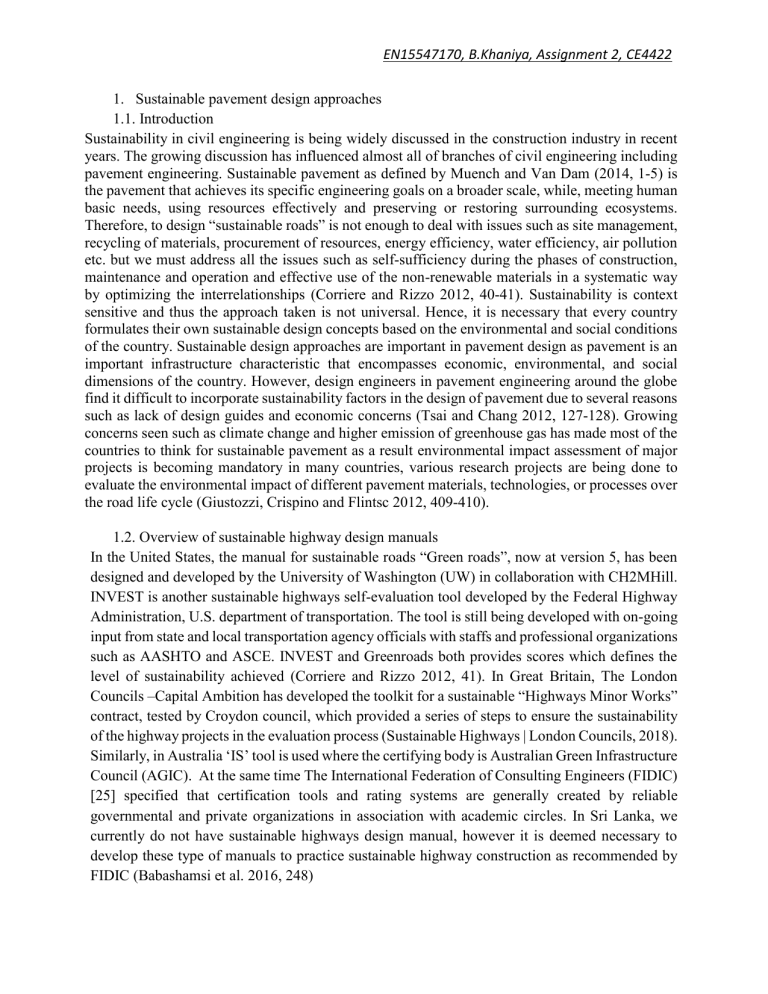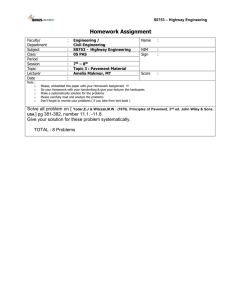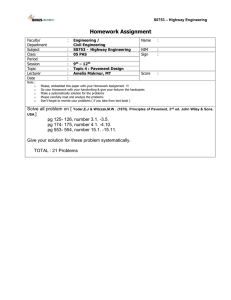
EN15547170, B.Khaniya, Assignment 2, CE4422 1. Sustainable pavement design approaches 1.1. Introduction Sustainability in civil engineering is being widely discussed in the construction industry in recent years. The growing discussion has influenced almost all of branches of civil engineering including pavement engineering. Sustainable pavement as defined by Muench and Van Dam (2014, 1-5) is the pavement that achieves its specific engineering goals on a broader scale, while, meeting human basic needs, using resources effectively and preserving or restoring surrounding ecosystems. Therefore, to design “sustainable roads” is not enough to deal with issues such as site management, recycling of materials, procurement of resources, energy efficiency, water efficiency, air pollution etc. but we must address all the issues such as self-sufficiency during the phases of construction, maintenance and operation and effective use of the non-renewable materials in a systematic way by optimizing the interrelationships (Corriere and Rizzo 2012, 40-41). Sustainability is context sensitive and thus the approach taken is not universal. Hence, it is necessary that every country formulates their own sustainable design concepts based on the environmental and social conditions of the country. Sustainable design approaches are important in pavement design as pavement is an important infrastructure characteristic that encompasses economic, environmental, and social dimensions of the country. However, design engineers in pavement engineering around the globe find it difficult to incorporate sustainability factors in the design of pavement due to several reasons such as lack of design guides and economic concerns (Tsai and Chang 2012, 127-128). Growing concerns seen such as climate change and higher emission of greenhouse gas has made most of the countries to think for sustainable pavement as a result environmental impact assessment of major projects is becoming mandatory in many countries, various research projects are being done to evaluate the environmental impact of different pavement materials, technologies, or processes over the road life cycle (Giustozzi, Crispino and Flintsc 2012, 409-410). 1.2. Overview of sustainable highway design manuals In the United States, the manual for sustainable roads “Green roads”, now at version 5, has been designed and developed by the University of Washington (UW) in collaboration with CH2MHill. INVEST is another sustainable highways self-evaluation tool developed by the Federal Highway Administration, U.S. department of transportation. The tool is still being developed with on-going input from state and local transportation agency officials with staffs and professional organizations such as AASHTO and ASCE. INVEST and Greenroads both provides scores which defines the level of sustainability achieved (Corriere and Rizzo 2012, 41). In Great Britain, The London Councils –Capital Ambition has developed the toolkit for a sustainable “Highways Minor Works” contract, tested by Croydon council, which provided a series of steps to ensure the sustainability of the highway projects in the evaluation process (Sustainable Highways | London Councils, 2018). Similarly, in Australia ‘IS’ tool is used where the certifying body is Australian Green Infrastructure Council (AGIC). At the same time The International Federation of Consulting Engineers (FIDIC) [25] specified that certification tools and rating systems are generally created by reliable governmental and private organizations in association with academic circles. In Sri Lanka, we currently do not have sustainable highways design manual, however it is deemed necessary to develop these type of manuals to practice sustainable highway construction as recommended by FIDIC (Babashamsi et al. 2016, 248) EN15547170, B.Khaniya, Assignment 2, CE4422 2. Sustainable design approaches focusing economic values 2.1. Cost Benefit Sustainable design technique (CBA approach) According to Browne and Ryan (2011, 228) CBA is normally used to evaluate finances of road construction in terms of congestion reduction advantages like reducing travel time and vehicle operating costs. To follow the CBA approach first, the potential expenses of pavement alternatives are estimated. Then, the probable advantages of each alternative are evaluated. At the end, all alternatives are compared based on the criteria of costs and benefits. In the CBA approach, unlike LCCA, the costs are countered by the respective benefits, which assert higher costs for greater benefits. However, both of these approaches are feasible in terms of deterministic or probabilistic values. 2.2. Life-Cycle Cost Analysis design approach (LCCA) Like CBA, LCCA can be classified according to two approach types: deterministic and probabilistic. LCCA is an economic method of evaluating financing alternatives intended to attain a comparative analysis of the overall cost-benefits of all possible options. The basic objective of economic evaluation is to demonstrate that a selected project is dependent on the available finances so that a sustainable design approach can be selected (FWHA 1998, 5-26). At the same time Ozbay et al. (2004, 65) stated that LCCA application would surely increase if the public and policy makers demanded better resource management. 3. Sustainable design approaches currently being used 3.1. Life-Cycle Assessment (LCA) Life-cycle assessment analysis is one of the presently accessible methods to determine the effects of construction processes on the environment. The LCA is authorized and supervised by ISO 14040 for carrying out the various assessment processes. In the field of LCA for highways, different methodologies are employed to evaluate the environmental effects of LCA. Each method is characterized by significant and unique benefits and drawbacks. Economic input–output (EIO) analysis is utilized in order to provide a holistic framework to trace the impacts across the supply chains in addition to direct impacts related to asphalt production processes in LCA method (Kucukvar et al. 2014, 1187-1195) The most comprehensive and agreed method incorporates material extraction, construction product manufacturing, the overall construction process, maintenance and operation, and recycling upon life cycle completion (Treloar et al. 2004, 43-49). 3.2. Multi-Criteria Decision Analysis (MCDA) Beria et al. (2012, 138) defined Multi-Criteria Decision Analysis (MCDA) as a tool for selecting between various projects that have many variables, such as social, economic and environmental impacts. MCDA is the most suitable tool to assist with the decision-making process currently used. The procedure used in MCDA is first setting multiple objectives, criterion limitations, and the use of weighting values to evaluate various criteria. The key problem in pursuing MCDA, which EN15547170, B.Khaniya, Assignment 2, CE4422 remains unresolved, is the difference between partial and objective decisions. The concept is referred to as “the black box” by Sayers et al. (2003, 100-105). 3.3. Environmental Impact Assessments (EIA) Estimating the influence of a pavement project to assist decision-making is defined as the intention of environmental impact assessment. In EIA, All powerful impacts like societal, environmental, operational and economic impacts are illustrated in the comprehensive review that is obligatory for existing pavement ventures (Yu 2013, 18-36). The EIA is regarded as the initial step towards sustainability impact assessment and the former must be integrated with other impact assessment tools. EIA does not specify the process of how a project underwent manufacturing but only educates on what needs to be done. 3.4.Social Life-Cycle Assessment (SLCA) SLCA is a broad concept and basic in social impact efficiency. It is a multi-desplinary modelling approach to assess the social effects of pavement projects. Jørgensen et al (2007, 97-102) indicated that SLCA approaches are yet in developmental stages with room for further development. However, it was also asserted that including relevant consequences in the SLCA is necessary, as this might be helpful in rendering SLCA a dominant and effective decision support tool. 4. How to design a sustainable pavement?? Above mentioned criteria under section 3 are the procedures that can be followed to go for sustainable pavement however, the most important parameter in designing sustainable pavement is the use of the sustainable materials in the construction procedure. The following are some of the ways/choices of using sustainable materials to construct an environment friendly road/pavement: Re-use of waste as secondary raw materials Unused residual materials such as glass and rubber can be thought to be used as raw material in the pavement design at the same time local materials should be used as far as possible in the construction process. Proper focus should be given in material used as choice of material has huge implication for construction through cycle of extraction, processing, transportation, use and disposal. The Use of Wastewater in Construction of Base Course Layers in Pavement Structures Large amounts of wastewater are produced annually and treated for use in agriculture, irrigation and groundwater replenishment. The produced treated wastewater (TWW) can be used as an alternative to the millions of gallons of fresh water that are typically used in pavement construction. (Abed et al. 2017, 31-37) performed a research in this topic and found that TWW can be a suitable EN15547170, B.Khaniya, Assignment 2, CE4422 replacement for fresh water in base course layers in pavement construction by conducting several Proctor compaction and California Bearing Ratio (CBR) tests. Harnessing energy from roads It is necessary to think as pavement structure as a source of energy. Since many vehicle move on the pavement surface, pavement structure absorbs significant amount of energy within it, if we can devise some grid system to harness that energy, then that energy can be used to light up the roadside bulbs and for other activities. At the same time, renewable energy sources such as solar panel, wind turbines can be installed at the side of the roads so that they can generate energy required for operation of roadway structures at least. Use of efficient equipment with less embodied energy It is necessary to use optimal performing equipment which produces lesser greenhouse gas nad causes relatively less damage to the environment. At the same time work experience and behavior of the operator should be checked for better performance of equipment’s. Corrections should be made in inability to measure the instantaneous fuel consumption, and multiplicity of available engines from environmental point of view. 5. Conclusion Hence, the sustainable design approaches currently being practiced in the pavement construction industry and the recommendations have been discussed in this report. It is necessary that all the designers be aware of these design approaches so that we can make this earth more sustainable. It is recommended that all the designers should be trained to assess all these approaches and incorporate these in their designs. 6. References 1) Abed, Farid H., Munir D. Nazzal, Mousa F. Attom, Magdi E. El-Emam, Nouran ElMessalami, and Saif Al-Dabagh. 2017. The Use of Wastewater in Construction of Base Course Layers In Pavement Structures. Advancement, In the Design and Performance of Sustainable Asphalt Pavements, 31-37. DOI: 10.1007/978-3-319-61908-8_3. 2) Babashamsi, Peyman, Nur Md Yusoff, Halil Ceylan, Nor Md Nor, and Hashem Salarzadeh Jenatabadi. 2016. Sustainable Development Factors In Pavement Life-Cycle: Highway/Airport Review. Sustainability 8 (3): 248. DOI: 10.3390/su8030248. EN15547170, B.Khaniya, Assignment 2, CE4422 3) Beria, P.; Maltese, I.; Mariotti, I. Multi-criteria versus Cost Benefit Analysis: a comparative perspective in the assessment of sustainable mobility. Eur. Transp. Res. Rev. 2012, 4, 137–152. 4) Browne, D.; Ryan, L. Comparative analysis of evaluation techniques for transport policies. Environ. Impact Assess. Rev. 2011, 31, 226–233. 5) Corriere, Ferdinando, and Angela Rizzo. 2012. Sustainability in Road Design: A Methodological Proposal for the Drafting of Guideline. Procedia - Social and Behavioral Sciences 53: 39-48. DOI:10.1016/j.sbspro.2012.09.858. 6) FHWA. Life cycle cost analysis in pavement design demonstration. Project 115, Participant Handbook, S. l.;U.S. Department of Transportation: Washington, DC, USA, 1998. 7) Giustozzi, Filippo, Maurizio Crispino, and Gerardo Flintsch. 2012. Multi-Attribute Life Cycle Assessment Of Preventive Maintenance Treatments On Road Pavements For Achieving Environmental Sustainability. The International Journal Of Life Cycle Assessment 17 (4): 409-419. DOI: 10.1007/s11367-011-0375-6. 8) Jørgensen, A.; Bocq, A.; Nazarkina, L.; Hauschild, M. Methodologies for social life cycle assessment. Int. J. Life Cycle Assess. 2007, 13, 96–103. 9) Kucukvar, Murat, Mehdi Noori, Gokhan Egilmez, and Omer Tatari. 2014. Stochastic Decision Modeling For Sustainable Pavement Designs. The International Journal of Life Cycle Assessment 19 (6): 1185-1199. DOI:10.1007/s11367-014-0723-4. 10) Muench, Steve, and Tom Van Dam. 2014. PAVEMENT SUSTAINABILITY. E- Book. 1st ed. Washington, USA: Federal Highway Administration (FHWA). 11) Ozbay, K.; Jawad, D.; Parker, N.A.; Hussain, S. Life cycle cost analysis: state of the practice versus state of the art. J. Transp. Res. Board 2004, 1864, 62–70 12) Sayers, T.M.; Jessop, A.T.; Hills, P.J. Multi-criteria evaluation of transport options flexible, transparent and user-friendly. Transp. Policy 2003, 10, 95–105. EN15547170, B.Khaniya, Assignment 2, CE4422 13) Treloar, G.J.; Love, P.E.D.; Crawford, R.H. Hybrid Life-Cycle Inventory for Road Construction and Use. J. Constr. Eng. Manag. 2004, 130, 43–49. 14) Tsai, Calista Y., and Andrew S. Chang. 2012. Framework For Developing Construction Sustainability Items: The Example Of Highway Design. Journal of Cleaner Production 20 (1): 127-136. DOI:10.1016/j.jclepro.2011.08.009. 15) U, Bin. 2013. Environmental Implications of Pavements: A Life Cycle View. Graduate, University of South Florida. 16) Sustainable Highways | London Councils". 2018. Londoncouncils.Gov.Uk. https://www.londoncouncils.gov.uk/node/3519. [Accessed date: 9/27/2018]



